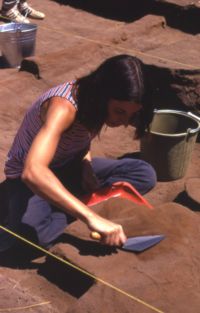Anthropology
Anthropology[1] is the holistic study of humankind. It studies all aspects of human life in all geographic regions of all time periods, from its evolution as Homo sapiens to its diverse manifestations within cultures and societies both past and present. Since recorded history, people have sought answers to such probing questions as Who are we? How have we come to be as we are? How can diverse peoples peaceably co-exist? and What might the past and present tell us about our future? Anthropology seeks to answer these and many other fundamentally humanistic questions.
Anthropology employs both qualitative and quantitative research methods within its numerous sub-disciplines. Common to all anthropologists is the method of fieldwork. A physical anthropologist may observe wild or captive primates, or dig pre-historic sites in Central Africa to discover clues about humankind's origins and early migration patterns, while an applied anthropologist plays games with inner-city Chicago schoolchildren to advise administrators on how to create conflict-reducing after-school programs. A sociocultural anthropologist may live in a hut among Haitian peasants to learn the meanings of their unique Anthropology, ritual in|rituals]] and political economy, while a linguistic anthropologist interacts with modern Chamorro language speakers at a barbecue to discover clues to their cultural retention amidst a globalizing society. Within each of these and the myriad other ways and places in which anthropologists conduct day-to-day research, they seek answers to benefit humankind. Anthropology has been described as "the reformer's science", and "the most humanistic of the sciences and the most scientific of the humanities".
The development of anthropology
- (See main article, Anthropology, history of)
How did anthropology begin? Although humans have probably always studied other humans in one way or another, the first formal study of human variation can be found in the work of the fifth-century Greek historian Heredotos, who compared the beliefs and customs of Athenians with those he called "barbarians" outside of the Greek city-state center. Beginning eleven centuries later, and spurred largely by descriptions of distant peoples found in the travel logs of European explorers and colonizers, Renaissance-era thinkers such as Michel de Montaigne in the sixteenth century, Thomas Hobbes in the seventeenth century, and Giambattista Vico of the eighteenth century, sought to account for human variation, while defending the variation from relativist notions in their day. Eighteenth century European Enlightenment thinkers continued with the interest, when John Locke, David Hume, Immanuel Kant, Charles Montesquieu, and Jean-Jacques Rousseau took into account cultural differences as they developed their theories of human nature, morality, and social organization. The formal interest in studying differing peoples during the period perhaps pinnacled within Montesquieu's Lettres persanes, in which he compared Persians with the French, as well as within the work of contemporaneous human anatomists who undertook measurements of the body such as cephalic index.
Yet it was not until the early nineteenth century that the first attempts to organize anthropology as a formal discipline under formal theories emerged, following publication of Charles Darwin's Origin of Species that offered a new way to look at the origins of humankind and the many facets of human cultures. Herbert Spencer and Henry Maine of Britain, and Lewis Henry Morgan along with Edward B. Tylor of the United States, selected a social-Darwinian perspective of human variation, while attempting to gain a surer footing for the emerging discipline of anthropology among the established sciences of academia. Within these early works, societies were viewed as progressing along a single continuum, from primitive to modern. In Morgan's scheme, societies evolved in seven stages, from "low savagery" to "civilization", with Western European societies being the civilized standard by which other societies were to be measured (see ethnocentrism), a perspective that provided handy justification for worldwide European colonial exploits during the time. The "primitive"/"civilized" dichotomy would not be seriously challenged within anthropology for nearly another hundred years.

Among the first scholars to challenge some of the early assumptions of anthropologists about environmental determinism and evolutionism was Franz Boas, who in 1883 joined an expedition to Baffin Island to record the influence of climate on culture. His findings led him in another direction, however, suggesting that culture is a product of social history rather than physical environment. An extremely influential figure in the field, Boas and his students (who included Margaret Mead, Ruth Benedict, and Alfred Kroeber) turned the focus of anthropology away from the study of the physical human being toward the study of human cultures.
Functionalism
Structuralism
The many facets of anthropology today

Anthropology in the United States is traditionally divided according to the four field approach. The fields include archaeology, physical or biological anthropology, sociocultural anthropology and linguistic anthropology. This is a useful way to organize the diverse field of anthropology, but it is by no means the only way that this is done. In Europe, for example, what are considered subfields or subdisciplines of anthropology in North America often stand as independent departments, such as Ethnology, Social Anthropology, Classical Archeology, or Ancient Civilizations. They may also be found as groups within other disciplines, such as ethology and physical anthropology within biology departments or medical schools. (Topics addressed by linguistic anthropology are frequently addressed by scholars in ethnology, linguistics, schools of education, and language departments.) What is more, the traditional fields of anthropology are now supplemented by the growing fields of applied anthropology, forensic anthropology, ethnomusicology, ethnobotany, cultural ecology and various other specialized subdisciplines. Each subdiscipline approaches the study of humans from a slightly different perspective, but they come together to give us a more holistic understanding of ourselves than any one of them could provide individually.
Common to all subdisciplines is the practice of cross-cultural analysis. It uses examples of similarity or difference found in two or more cultures to make broader observations about structures of human thought, action, and social organization. This might take the form of comparing data from neighboring cultures like the Kumeyaay and the Cahuilla peoples of southern California to learn more about a particular culture area or it could involve the comparison of data from Guatemala and Vietnam to study approaches to economic integration in developing countries.
Archaeology
Archaeology has been called "the past tense of anthropology."[4] It studies material remains as a way to understand the people who created those remains. This includes charting settlement patterns, economic structures, religious institutions, dietary regimens, art forms, people's interactions with their environments and much more. Archaeologists generally make use of two techniques, called "surveys" and "excavations," to piece together the lives of the past inhabitants of a site.
Surveys are the more recent of the two tools. They are often performed before excavations in order to give the archaeologist a preliminary picture of the site, but they are also sometimes conducted in place of an excavation because they are less expensive and faster to implement and because they cause less irreversible damage to the site. Surveys create a map of the site using various methods (including human recorders, aerial photography, and magnetometers) to comb an area and record the type and location of artifacts and features.
Excavations systematically remove layers of soil in an area of interest in order to discover the different ways that the site was used over time. Excavations are necessarily a destructive process, and must be conducted with great care. Archaeologists record the precise location, or provenance, of the artifacts and features that are discovered and then look at the spacial and temporal relationships between their discoveries.
Physical anthropology
Physical or biological anthropology studies humans as a biological species, often through the study of and comparison with non-human primates. Physical anthropologists study genetics and physiology in modern populations as well as in the fossil record in order to learn more about the processes of human evolution and adaptation.
Probably the most prominent current project in the field of physical anthropology is The Genographic Project. Genographic has launched an effort to collect DNA specimens from indigenous populations around the world as a tool to help them trace prehistoric patterns of human migration. They compare the characteristics that they observe in each human population with the characteristics of other populations to identify their common ancestors and determine how long ago those populations diverged.
Sociocultural anthropology

Photo © by Tom E. Fricke, used by permission.
Sociocultural anthropology is the branch of anthropology that is most often associated with the term "anthropology." It studies the abstract structures that help people to better understand the world around them and to interact with each other and their environments. This branch studies kinship structures, subsistence strategies, religious and cosmological beliefs, and the myriad of other constructs that work together to determine a person's experience of the world.
Sociocultural anthropologists conduct two different types of research: ethnography and ethnology. Ethnographers try to learn everything they can about a particular culture within a short time frame (this could be as long as years or even decades in some cases). Ethnology is cross-cultural - it compares data collected about multiple cultures.
Sociocultural anthropology is heavily reliant on participant observation. This is a systematic approach to the recording of cultures, the development of which is generally credited to Bronislaw Malinowski. An anthropologist will live with the people that he or she is interested in studying and take part in the every-day activities, and special rituals of those people in order to learn the explicit and tacit aspects of their culture. [5] The researcher then carefully records his or her observations in field notes for later use in cultural analysis.
Methods of research in sociocultural anthropology also include interviews, questionnaires, and content analysis.
Linguistic anthropology
Linguistic anthropology studies people through their use of language. This includes studies of written language, oral expression, sign languages such as American Sign Language, and various forms of nonverbal communication like smiles and waves. Linguistic anthropologists research the meaning that is created by these different types of communication as well as the context in which that meaning is created. They seek to learn what the differences are between the language that different people use in similar situations as well as the variations in the language that a single person uses in different situations.[6]
Edward Sapir and Benjamin Whorf are widely cited as the most important figures in this field, due to the theory that became known as the Sapir-Whorf Hypothesis. This theory comes in two forms: strong linguistic determinism and weak linguistic determinism. The "strong" formulation says that the way that a person thinks is completely dependent on the language that the individual speaks. The "weak" version claims that a person's thoughts are merely influenced (though they may be influenced rather strongly) by the person's language. This second version of linguistic determinism is a major assumption in much of the research that is conducted in the field of linguistic anthropology whereas the "strong" version is more often rejected for being too exacting.
Linguistic Anthropology is closely related to the fields of anthropological linguistics, which studies language through the biological human and sociolinguistics, which studies the ways that societal structures influence language use.
Applied anthropology
Applied anthropology plays an important part in our study of humans because it takes anthropology out of the library and puts it to use in the world by drawing on the knowledge that is gained through the other branches of anthropology and applying the results as a way to expand upon them. Applied anthropologists undertake their research with the goal of integrating "anthropological perspectives and methods in solving human problems throughout the world." [7]
Anthropology reconsidered
Successes of anthropology
Ethics and controversy
The continuing story
The postmodern challenge
Education for Anthropology
References
- ↑ Etymology: The word "anthropology" is formed by combining two Greek words "anthropos" ("human") and "logia" ("study").
- ↑ T.K. Pennimen (1965). A Hundred Years of Anthropology. London: Gerald Duckworth & Co. Ltd.. ASIN: B0000CMJT7.
- ↑ Eriksen, Thomas Hylland; Finn Sivert Nielsen (2001). A History Of Anthropology. London: Pluto Press. ISBN: 0-74-531385-X.
- ↑ Colin Renfrew and Paul Bahn. (2004) Archaeology: Theories, Methods, and Practice. ISBN 0-500-28441-5
- ↑ Kathleen M. Dewalt, Billie R. Dewalt, with Coral B. Wayland. Participant Observation. In Handbook of Methods in Cultural Anthropology. H. Russel Bernard, Ed. Pp. 259-299. ISBN 0-7619-9151-4
- ↑ Nancy Bonvillian. (2003) Language, Culture, and Communication: The Meaning of Messages, Fourth Edition. ISBN 0-13-097953-8.
- ↑ Society for Applied Anthropology. Purpose and Vision. Electronic document, http://sfaa.net/sfaagoal.html. Archived March 31, 2007.




